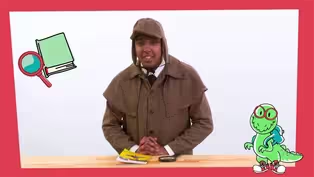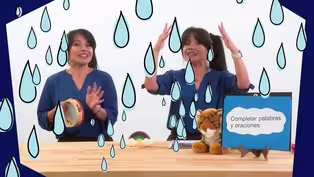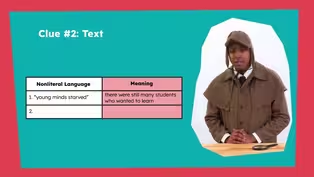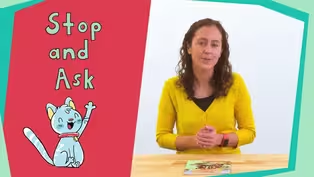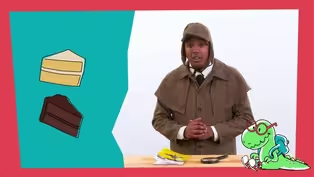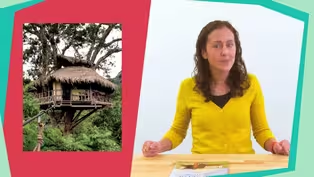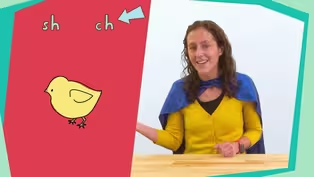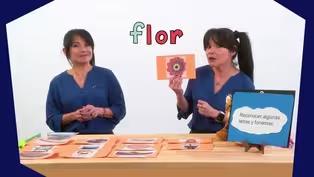
Episode 27 | Literacy Lessons
4/13/2021 | 28m 46sVideo has Closed Captions
Literacy lessons for early learners, led by NC teachers.
The first lesson (aimed at PreK-K learners) helps students understand that reading happens from left to right. The second lesson (aimed at 1st-2nd graders) helps learners identify story elements and key details of text. Classroom Connection is your At-Home Learning companion where children love to learn. All lessons are led by NC educators.
Problems playing video? | Closed Captioning Feedback
Problems playing video? | Closed Captioning Feedback
At-Home Learning Presents: Classroom Connection is a local public television program presented by PBS NC

Episode 27 | Literacy Lessons
4/13/2021 | 28m 46sVideo has Closed Captions
The first lesson (aimed at PreK-K learners) helps students understand that reading happens from left to right. The second lesson (aimed at 1st-2nd graders) helps learners identify story elements and key details of text. Classroom Connection is your At-Home Learning companion where children love to learn. All lessons are led by NC educators.
Problems playing video? | Closed Captioning Feedback
How to Watch At-Home Learning Presents: Classroom Connection
At-Home Learning Presents: Classroom Connection is available to stream on pbs.org and the free PBS App, available on iPhone, Apple TV, Android TV, Android smartphones, Amazon Fire TV, Amazon Fire Tablet, Roku, Samsung Smart TV, and Vizio.
Providing Support for PBS.org
Learn Moreabout PBS online sponsorshipMore from This Collection
Video has Closed Captions
Literacy lessons for early learners, led by NC teachers. (28m 46s)
Video has Closed Captions
Literacy lessons for early learners, led by NC teachers. (28m 46s)
Video has Closed Captions
Literacy lessons for early learners, led by NC teachers. (28m 45s)
Video has Closed Captions
Literacy lessons for early learners, led by NC teachers. (28m 45s)
Video has Closed Captions
Literacy lessons for early learners, led by NC teachers. (28m 46s)
Video has Closed Captions
Literacy lessons for early learners, led by NC teachers. (28m 46s)
Video has Closed Captions
Literacy lessons for early learners, led by NC teachers. (28m 45s)
Video has Closed Captions
Short Description: Literacy lessons for early learners, led by NC teachers. (28m 45s)
Video has Closed Captions
Literacy lessons for early learners, led by NC teachers. (28m 45s)
Video has Closed Captions
Literacy lessons for early learners, led by NC teachers. (28m 45s)
Video has Closed Captions
Literacy lessons for early learners, led by NC teachers. (28m 45s)
Video has Closed Captions
Literacy lessons for early learners, led by NC teachers. (28m 45s)
Providing Support for PBS.org
Learn Moreabout PBS online sponsorship[cheerful upbeat music] ♪ - What's good my good people?
I'm Mr. R, and I'm gonna be your guide on today's learning journey.
There's gonna be some twists and some turns, but mostly we're gonna have some fun.
- Hello super learners.
My name is Miss Jennifer, and I'm so excited that you're here to learn with me today.
You will need a piece of paper, a pencil, and a stuffed animal for today's lesson.
Ask a trusted adult to help you find these items.
While you're getting your supplies, I'm gonna grab mine as well.
I'll be right back.
[upbeat music] Okay, I'm back now.
And I see you are too.
We have our supplies, super learners, so let's get started.
Today we are gonna read a story about animals that live on a farm.
We are going to practice reading our words from left to right, and learn to read some heart words.
Are you ready?
Let's get started.
Before we can begin reading our book, we need to learn some words.
These are a special kind of word.
They are called heart words.
We call these words heart words because we are practicing reading them so that we will know them by heart, or so that we won't have to sound them out.
Our words for today are look, at, and the.
I have some heart word cards that I made using index cards and a marker.
You can make your own heart word cards using your piece of paper and a pencil.
All you need to do is fold your paper in half like this.
Then, fold your paper in half again like this.
And now you have four spaces to write your heart words.
Ask a grown-up for help if you need to.
Now, I'm going to use a marker to write my words, but you can use whatever writing utensil you have available.
Let's start by making our heart word cards.
The first word we will be reading today is look.
In one of the spaces on your paper, you're going to write the word "look."
Remember that we always start on the left and go to the right.
Our first letter is L. To write a letter L, you start at the top and make a straight line down.
Next, we need two letter Os.
To make the letter O, just make a circle.
Make two of them.
Last, we need the letter K. To make a K, start at the top, make a straight line down.
Then, go about halfway on your straight line and make a slanted line up, and then a slanted line down, like this.
And now you have the word "look."
Show your friend your word.
Now let me see.
[gasping] Great job!
Now let's write the word "at" in a different space on your paper.
This word begins with the letter A.
To make an A, we're going to make a circle.
Then, start at the top of your circle and make a straight line down that touches your circle, like this.
Now we need a letter T. To make a letter T, start at the top, and make a straight line down.
Then, jump back up about halfway and make a line across from left to right.
And now you have a letter T. Show your word "at" to your stuffed friend.
Now let me see.
Great job!
Our last heart word is "the."
Choose an empty space on your paper for your word.
First, we need the letter T. We just wrote a letter T in our word "at."
Do you remember how to write it?
Let's do it together.
Start at the top, make a straight line down.
Then jump back up about halfway and make a line from left to right.
Next, we need the letter H. To make an H, start at the top, make a straight line down, then jump about halfway up the line and make a curved line down to the bottom.
The last letter we need is the letter E. To make an E, make a curved line down to the bottom.
Then, jump back to the top, and make a line that slides to the left.
Show your word "the' to your stuffed friend.
Now let me see.
I like how your letters are written from left to right.
Great job!
Now that we have our heart word cards, let's practice reading and spelling our words.
Our first word is, "look."
Read it with me.
"Look."
Now, let's point to each letter and say its name.
L-O-O-K. Great job!
Point to each letter and tell your stuffed friend.
L-O-O-K. We did it!
Our next word is "at."
Read it with me, "at."
Now, point to your word and say "at" to your stuffed friend.
Great.
Now let's point each letter and spell the word at.
A-T. Now point to each letter in your word and say them to your stuffed friend.
A-T. Great job spelling at!
Our last word is "the."
Read it with me.
The.
Now, point to your word and say the word "the" to your stuffed friend.
Great.
Now, let's point each letter and spell the word "the."
T-H-E. Now, point each letter in your word and say them to your stuffed friend.
T-H-E. Wow!
Now we can read and spell three heart words.
Look, at, and the.
Now, let's take a look at our book that we will be reading today.
The title of our book is "At Home on the Farm."
This story is about different types of homes that each animal uses on a farm.
Let's take a look at the pictures.
In this picture, we can see a barn.
And over here we can see a cow.
Now, let's look at the barn.
Now I want you to read this page with your stuffed animal.
Look at the barn.
Did you see our heart words on this page?
Yes!
We were able to read our heart words.
Look, at, the.
Now let's read the next page to see what animal lives in the barn.
Look at the cow.
Now I want you to read this page to your stuffed friend.
Look at the cow.
Did you see our heart words on this page again?
We sure did.
Look at the pen.
Did you see our heart words on this page?
Yes, because we read, look at the pen.
Great reading.
Let's read on to see which animal lives in a pen.
Look at the pig.
Now I want you to read this page to your stuffed friend.
Point to the words and read them again.
Look at the pig.
What farm animal did we look at on this page?
Right, the pig.
Look at the hen house.
Hm, now I want you to read this page to your friend.
Look at the hen house.
What animal do you think lives in a hen house?
Right, a hen or a chicken.
Look at the hen.
Now I want you to read this page to your stuffed friend.
Did you see your heart words on this page?
Yes.
We read, look at the hen.
Great reading.
Look at the farm.
Now, I want you to read this page to your stuffed friend.
Did you see our heart words?
Look at the farm.
Great reading.
Now that we've practiced reading our heart words, look, at, and the, we can read those words in other texts without having to sound them out.
We're at the end of our lesson, super learners, and you have done such a great job reading the heart words, look, at, and the.
Thank you so much for being with me as we learned some heart words and read a book using those words.
Keep practicing reading and spelling, look, at, and the.
See you next time.
- Today's lesson was so cool.
I feel like I'm a little stronger each time I learn something.
Does your brain feel good and strong?
I feel sharp right now, and I'm excited to keep the day going.
- My name is Nicole.
I'm nine years old, and my girl powers are dancing and reading.
♪ Beautiful ♪ ♪ You're beautiful ♪ ♪ Crazy kind of beautiful ♪ Your hands and feet have to work together, 'cause if you don't, it would look like a big blob of mess.
[upbeat music] I've been dancing for six years.
I do ballet and jazz.
I used to do tap last year.
Well, ballet is more like graceful.
Jazz is like, you have more choices to like what category you want to dance in.
Jazz my favorite type of dance because you got to express your feelings.
And when you ever go, when you go to class, you get to make new friends.
I would describe jazz dancing as sassy because I like the way that you like pop your hips and sit in them.
- [Dance Instructor] Let's go!
[upbeat music] - [Nicole] My older sister is one of my inspiration for dance.
And she does ballet, jazz, and Chinese dancing.
She sometimes helps me with my jazz combinations.
- Point foot, yeah keep going.
- [Nicole] And when she does that, she like corrects my wrong moves.
And she like helps me do hard parts.
- [Sister] Every time you do an arm movement, make it really strong and sharp.
Yeah.
Woo!
[Sister clapping] High five.
Yay!
- When I watch her dance, I think that she's very good, and it makes, it motivates me to do jazz better.
My mom used to be a traditional Chinese dancer in China.
When I saw my mom dance, it was very graceful.
Their costumes are big colorful kimonos.
And they're usually green or pink.
The sleeves are like very long.
And whenever they like do arm swishes, it looks very graceful like the wind.
Another one of the things I really like to do is reading.
Whenever I read it makes me feel like I'm one of those characters.
And I go on adventures in the ocean and on islands.
I usually like fiction books that are on adventures, or mystery books.
I think we need more girl power in the world, because everybody has a different kind of thing that they like.
And so everybody will have like a chance to watch about somebody that has the same favorite things as they do.
So they feel happy about themselves too.
Embrace your girl power.
- I just read that kangaroos can't walk backwards.
Can you?
Don't try it now though, or you might miss this awesome literacy lesson.
- Hello readers.
My name is Ms. Gary, and I'm so excited to be learning with you today.
But before we get started with our learning, let's say hello with the Welcome Song.
♪ Hello readers ♪ ♪ Hello readers ♪ ♪ How are you ♪ ♪ How are you ♪ ♪ I'm so glad to see you ♪ ♪ I'm so glad to teach you ♪ ♪ Hello you ♪ ♪ You and you ♪ Readers, have you ever played a trick on someone?
How did that make the person feel when you tricked them?
Were they happy, or upset, or maybe even angry?
When someone has a trick played on them, they might say that they were fooled.
And in today's lesson, our story, we're going to see the word fooled.
And to fool someone means to trick them.
Do you think fooling someone is a nice thing to do?
Whisper your answer to me.
I agree.
Fooling someone is an unkind thing to do, and you may even get in trouble for it.
So today, we're gonna use our story elements to help us understand the story and determine what the lesson in the story is.
To do this, we're going to use our hands.
We're gonna practice something called the five finger retell.
And I love this strategy because I can use it any time to help me identify the story elements to discover the meaning of the story.
Sometimes I'll even use it when I'm reading.
And sometimes I use it when I'm listening to stories also.
So let's see what it means to use our five finger retell.
So I have my thumb.
My thumb is gonna be my characters.
The characters are the people or animals in the story.
Once you identify who the characters are, you put your thumb down, just like that.
Next is our pointer finger.
This finger tells us where the setting is.
The setting is when and where the story takes place.
So once you find that information out, you can put your pointer finger down as well.
The next finger is going to be our ring finger.
Our ring finger is the problem.
So what obstacles will our characters face?
Once we determine that, this finger can join our pointer and thumb, because we figured out the problem.
Now, the only thing left is our little finger.
Our little finger helps us by solving the big problems that the story characters have.
So, once I figure out what the story's solution is, I put that finger down.
But did you know that stories can also have lessons?
And using my five finger retell can help us figure out the greater lesson of the story.
So today, we're going to read a fable.
A fable has a lesson at the end of the story.
And the fable we're going to read today is "The Boy Who Cried Wolf."
We're going to be able to better understand while we're reading because we are gonna pay very close attention.
We're gonna see who the characters are, where this story takes place, what problem our characters encounter, and how this problem is solved.
And in this case, this information will help us determine what the lesson or meaning of this fable, "The Boy Who Cried Wolf" is.
So good readers will always pay close attention to the text so they can go back and use the details.
But they also will be able to figure out what it means.
So let's jump into our fable.
The title of this book is "The Boy Who Cried Wolf."
It's retold by Ingrid Helmer.
And it's illustrated by Natalia Vasquez.
Let's start reading.
The farmer's son had to keep the sheep safe.
His father said, "Just cry out if you see a wolf."
So every day the boy watched the sheep.
"The sheep are having so much fun," said the boy, "but I'm not."
"Would seeing a wolf be fun?"
he thought?
"No, that would be really scary.
"What if I pretended to see a wolf?
"That might be fun."
Then the boy stood up and he cried out, "Wolf!"
Then he cried out again, "Wolf!
Wolf!"
Oh no.
Everyone came running.
The farmer came running.
The farmer's wife came running.
His neighbors came running.
His neighbor's wife came running.
His neighbors three children came running too.
Everyone looked around.
The sheep were leaping and playing in the meadow.
The boy was sitting on his haystack.
"This is funny!"
said the boy.
"I really fooled you.
"You thought there was a wolf."
Was that very nice of the boy to fool them?
No way.
"This is not funny," said the farmer.
"You scared all of us.
"Now get back to work."
The farmer and his wife were not happy with their son.
And check out their faces.
They look pretty angry.
The next day the boy watched the sheep.
They were jumping and playing.
The sheep were having fun, but the boy was not.
Then the boy stood up.
What do you think he's gonna do?
And he cried, "Wolf!"
Then he cried again, "Wolf!
Wolf!
Wolf!"
So let's stop here, readers.
What's happening in our story so far?
The farmer's son is in the meadow watching the sheep.
He isn't having very much fun.
So what does he keep on crying out?
"Wolf!"
Is it making the people very happy?
No way.
So let's keep reading.
Everyone came running again.
The farmer came running.
The farmer's wife came running.
The neighbors came running.
His neighbor's wife came running.
His neighbors three children came running too.
Hmm, let's pause.
I want you to look at these faces.
They don't look very happy, do they?
No.
Everyone looked.
The sheep were safe.
The boy was laughing.
"I fooled you again," the boy said.
"This is not funny," said the farmer.
Don't ever do that again.
And look at him.
[clicking tongue] It's not very nice.
Uh oh, do you see that readers?
Hm, something suspicious behind that tree.
The next day was quiet.
The boy sat on the haystack.
Suddenly, he saw a wolf walking to the meadow.
The boy was very scared.
He knew he had to call for help.
He cried out, "Wolf!
Wolf!
Wolf!"
He waited, but no one came.
Hmm, I'm wondering readers, if the boy should've stopped fooling everyone like his father told him to.
Let's keep reading to see what happens next.
"What if everyone thinks I'm being funny?
"What if no one comes?
"I should have not fooled them," the boy thought.
The boy stood very still and waited.
Look at his face.
He looks a little bit afraid.
But then everyone came running.
The farmer came running.
The farmer's wife came running.
The neighbors came running.
The neighbor's wife came running.
His neighbor's three children came running too.
The wolf saw everyone running, and the wolf ran off into the woods.
And there he goes being chased off.
"You did a good job," said the farmer.
"And I have learned a lesson," his son said.
"I will only cry wolf when I see a wolf."
And that's what he did.
So now that we looked back in our text to identify the characters, the setting, the problem, and the solution, it's time to learn the lesson of our fable.
What lesson do you think the boy learned from our story?
The lesson is, you should always tell the truth.
Because if you don't, they'll never know if you were telling the truth.
And when you do, no one will believe you.
So we just read the fable, "The Boy Who Cried Wolf."
Now we're going to use the details from that text to retell the story.
We're going to use our five finger retell.
So to do that, I brought a special retelling friend.
It's my retelling five finger glove.
It has all of our elements on it and this will help us keep track of what happened in our story.
So, let's look at our thumb.
Our thumb is our characters.
Can you whisper to me and tell me who the characters in our story are?
I think I heard you say it was the farmer's son.
That's right.
So now I'm going to put my thumb down.
Now readers, I'm going to use my pointer finger to think about where did the story take place?
So think for a minute, and then tell me, where does the story take place?
That's right.
It's the meadow.
That's where the boy was watching the sheep.
So the setting is the meadow.
We know all about the setting in our story.
So I'm now gonna put my second finger down.
Now I'm going to think about the problem.
So our problem is, what happened with our characters?
Hmm, do you remember what we read and listened for?
Oh, I remember that awful fooling that he was doing.
He was playing tricks on everyone.
So now I can put down my problem finger.
But I'm still left with my little finger waiting for us to see how did the problem get solved.
So, we had a boy in the meadow fooling people.
But how was this problem solved?
That's right, readers.
All the people came and scared the wolf away, and he went running off into the woods.
So now I can put my pinkie down.
So we used the text details to help us identify the story's elements.
You'll be able to retell the story's beginning, middle, and end by using those story elements.
So listen to me retell "The Boy Who Cried Wolf."
The characters in "The Boy Who Cried Wolf" was the farmer's son.
He was in the meadow watching the sheep.
He kept crying out, "Wolf!"
and fooling everyone.
So when a real wolf came, nobody would help him.
But then, all the people came running, and scared the wolf off into the woods.
So you did a great job today, readers, by using details from the text to retell the story of "The Boy Who Cried Wolf."
You all have been great today, and I thank you so much for joining me, as we learned how to retell a story using our five finger retell.
Remember, you can use this any time to help you practice retelling a story.
I'll see you next time readers.
Bye!
- I can't believe how fast that lesson flew by.
I feel stronger and smarter already.
Can you flex for me?
Yeah!
Awesome.
Our brains are flexing too.
Gotta keep that mind fresh.
[cheerful upbeat music] ♪
Support for PBS provided by:
At-Home Learning Presents: Classroom Connection is a local public television program presented by PBS NC
